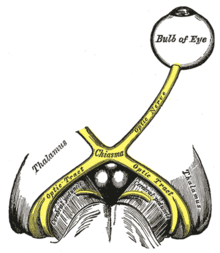Relative afferent pupillary defect
| Relative afferent pupillary defect | |
|---|---|
| Other names | Marcus Gunn pupil |
 | |
| The left optic nerve and the optic tracts. A Marcus Gunn pupil indicates an afferent defect, usually at the level of the retina or optic nerve. Moving a bright light from the unaffected eye to the affected eye would cause both eyes to dilate, because the ability to perceive the bright light is diminished. | |
| Specialty | Ophthalmology, Optometry |
A relative afferent pupillary defect (RAPD), also known as a Marcus Gunn pupil, is a
Depending on severity, different symptoms may appear during the swinging flash light test:
Mild RAPD initially presents as a weak pupil constriction, after which dilation occurs.
When RAPD is moderate, pupil size initially remains same, after which it dilates.
When RAPD is severe, the pupil dilates quickly.
Cause
The most common cause of Marcus Gunn pupil is a
Diagnosis
The Marcus Gunn pupil is a relative afferent pupillary defect indicating a decreased pupillary response to light in the affected eye.[3]
In the
Anisocoria is absent. A Marcus Gunn pupil is seen, among other conditions, in unilateral optic neuritis.[4] It is also common in retrobulbar optic neuritis due to multiple sclerosis but unreliable in bilateral optic neuritis.[4][5]
A total
See also
References
- ^ "Pupillary Responses". Stanford University School of Medicine. Retrieved 2015-11-04.
- Who Named It?
- ^ PMID 8937350.
- ^ S2CID 252564095.
- ^ Mumenthaler Neurology 4ed, Thieme 2004, page 486 Demyelinating diseases
